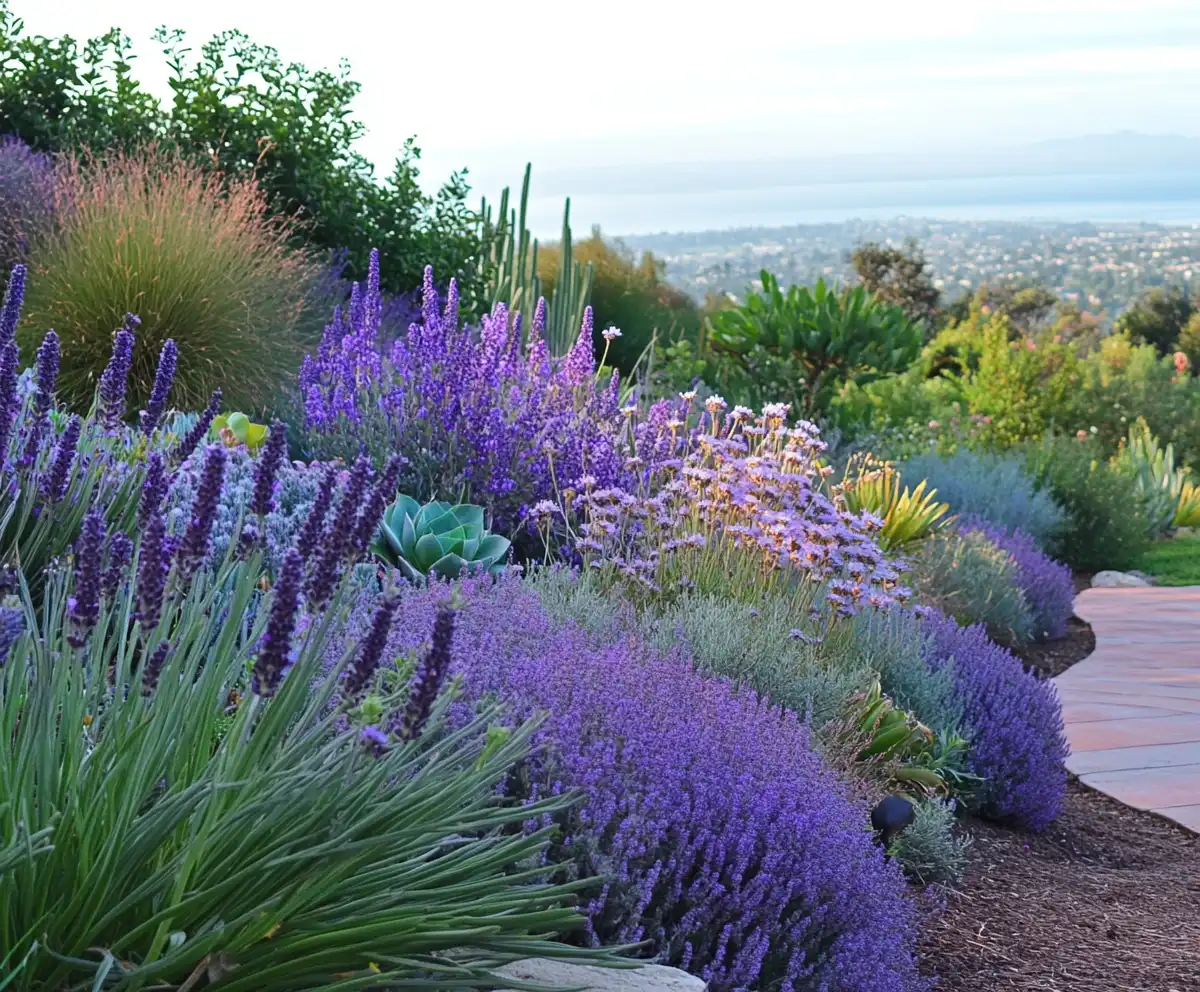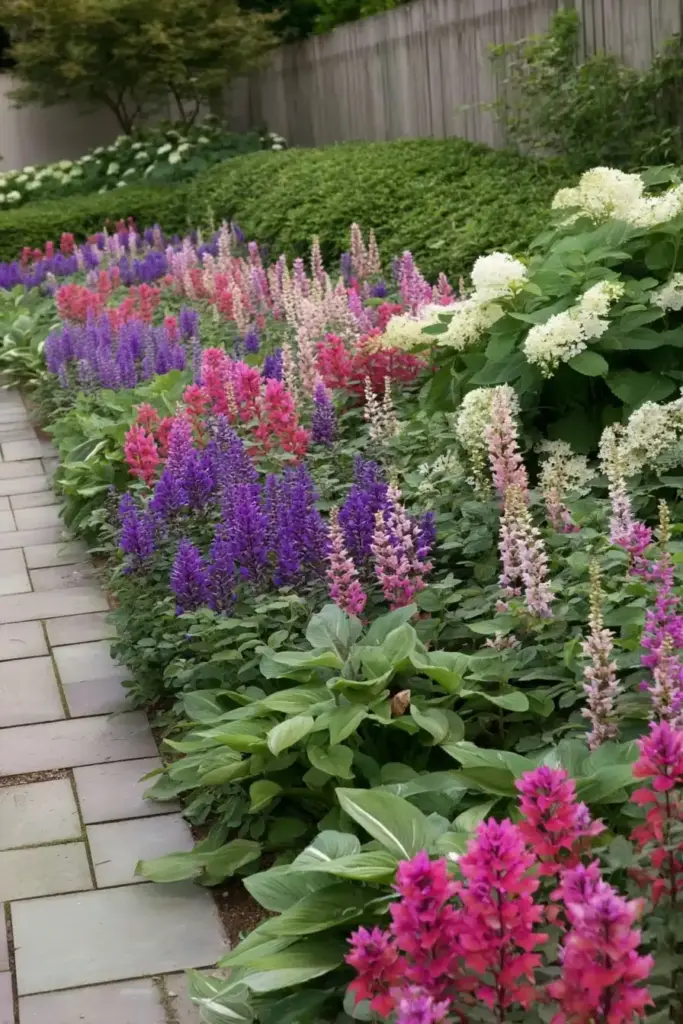Salvia landscaping ideas are a gardener’s secret to creating vibrant, fragrant, and low-maintenance outdoor spaces. Whether you’re designing a structured border like those found in flower bed ideas for the front yard, embracing a wild cottage garden, or crafting a drought-tolerant rock landscape, salvia offers unmatched versatility. This resilient and colorful perennial not only adds visual impact but also attracts pollinators—just like the selections in our top plants for a pollinator-friendly yard. In this article, you’ll discover 14 beautiful and practical ways to incorporate salvia into your garden—each idea tailored to different styles, spaces, and maintenance levels.
🌿 Love gardening inspiration? Follow me on Pinterest for bold plant ideas, tips, and seasonal color!
Table of Contents
🌸 1. Colorful Ground Cover
If your garden has bare patches or underused corners, salvia landscaping ideas can help transform those gaps into living tapestries. Low-growing salvia varieties, such as Salvia greggii or Salvia chamaedryoides, make excellent ground cover. These compact plants spread gently without overwhelming other flora, and their continuous blooms in shades of purple, red, and blue create a vibrant carpet effect.
Why Use Salvia as Ground Cover?
- Fills empty spaces naturally without crowding neighboring plants
- Attracts bees and hummingbirds, boosting pollination in the area
- Reduces weed growth thanks to dense foliage and ground coverage
- Thrives in full sun and requires minimal watering once established
For best results, plant salvia in clusters to encourage dense blooming. It’s also helpful to mulch around the edges to retain moisture and create a tidy look. This technique works beautifully in cottage gardens, border edges, or around stepping stones for a soft, colorful transition.
🌿 2. Scented Delights
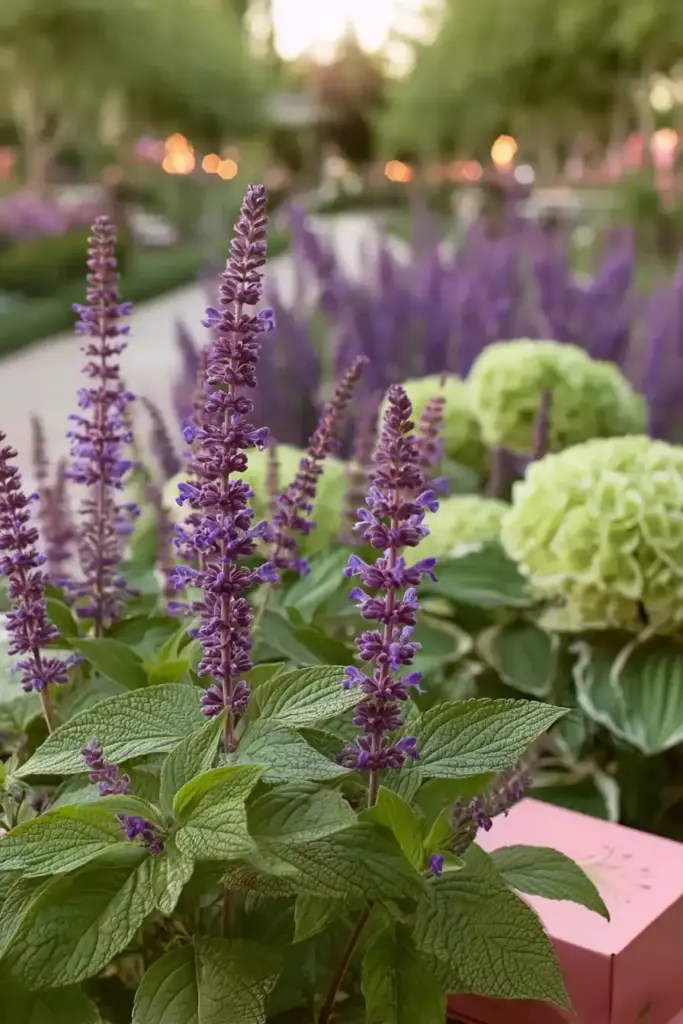
One of the most delightful salvia landscaping ideas involves selecting aromatic varieties that engage not just the eyes, but the senses. Many salvias, especially those in the Salvia officinalis (culinary sage) and Salvia dorisiana families, release a gentle fragrance from both leaves and flowers, making your garden a sensory haven.
Benefits of Scented Salvias
- Adds atmosphere to evening gardens—fragrance becomes more noticeable as temperatures rise
- Ideal near seating areas, patios, or windows where scent can be enjoyed regularly
- Attracts beneficial insects like bees and butterflies with both scent and nectar
- Can be harvested for cooking or herbal uses, offering both beauty and practicality
For best placement, tuck aromatic salvias along walkways or in raised beds near decks and entryways. Their scent will greet you with each breeze, enhancing the ambiance of your outdoor space.
🌺 3. Bold Border Planting

Looking to define your garden’s edges with a pop of personality? One of the most effective salvia landscaping ideas is using tall, vibrant salvia varieties as border plants. With their upright flower spikes and dense foliage, salvias like Salvia nemorosa or Salvia guaranitica create a striking frame along walkways, fences, or garden beds.
Why Choose Salvia for Borders?
- Establishes structure and gives definition to garden edges
- Adds bold, seasonal color with long-lasting blooms
- Blends well with other perennials, such as lavender, echinacea, or ornamental grasses
- Low-maintenance and deer-resistant, making them perfect for exposed areas
To create a dynamic border, alternate salvia with plants of contrasting height or color. For example, deep indigo salvia next to golden coreopsis or soft pink yarrow can turn a simple edge into a show-stopping focal point.
🪴 4. Easy Maintenance Landscaping
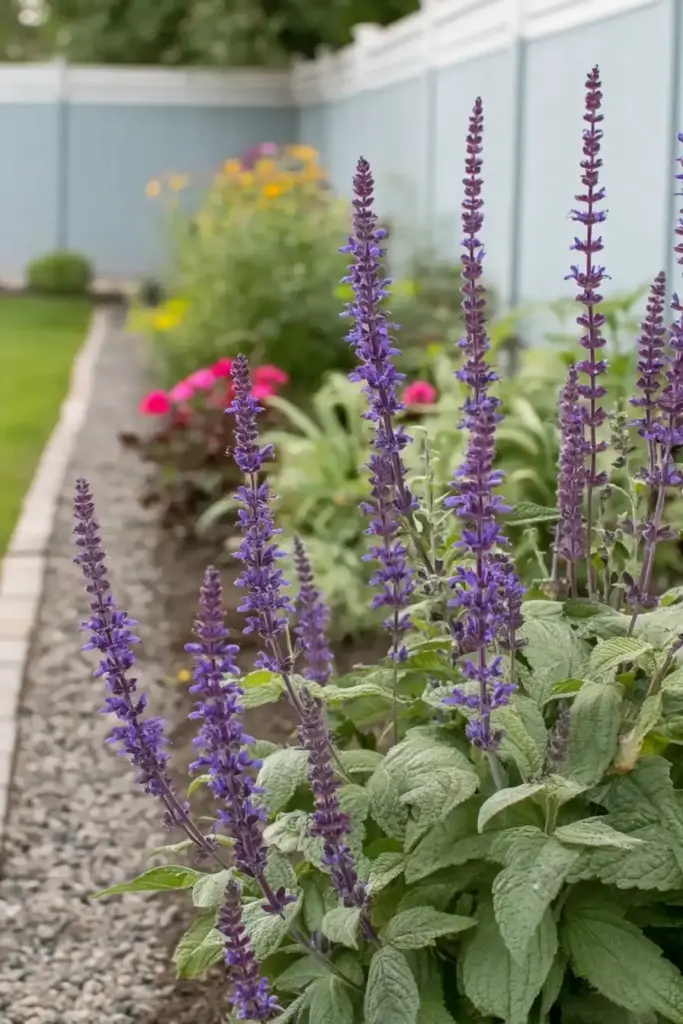
For gardeners who crave beauty without the burden of constant upkeep, salvia landscaping ideas offer an excellent solution. Salvias are known for their resilience—thriving in poor soils, resisting pests, and enduring long periods without water. This makes them a perfect choice for low-maintenance landscaping.
Key Advantages:
- Drought-tolerant once established, saving water and time
- Rarely affected by pests or disease, reducing the need for treatments
- Long blooming season, especially with occasional deadheading
- Self-sufficient—requires minimal fertilization or care
Use hardy varieties like Salvia x sylvestris or Salvia microphylla in open beds, xeriscape designs, or difficult-to-reach areas. Pair them with other low-maintenance plants like sedum, artemisia, or ornamental grasses to create a lush landscape that practically takes care of itself.
🪨 5. Rock Garden Elegance
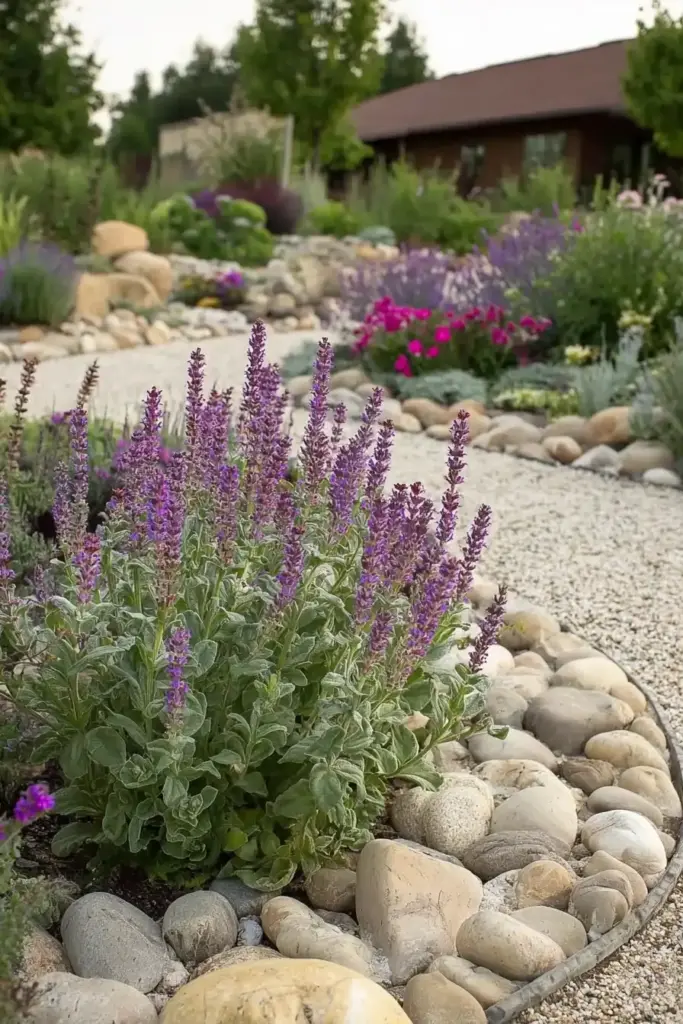
Rock gardens are all about texture, contrast, and minimalism—and salvia landscaping ideas fit right in. With their bold hues and upright forms, salvias bring life and motion to the calm, grounded look of stones and gravel. Varieties like Salvia rosmarinus (formerly rosemary) and Salvia reptans are particularly well-suited for rocky terrain.
Why Salvia Works in Rock Gardens:
- Thrives in well-draining soil, even sandy or gravel-heavy
- Contrasts beautifully with the neutral tones of stones and boulders
- Tolerates full sun and heat, ideal for exposed, rocky areas
- Supports pollinators in typically low-flower environments
To elevate your rock garden, plant salvias in pockets between stones, allowing them to spill slightly over rock edges. Their texture adds movement and softness to otherwise rigid designs, while their low water needs keep maintenance simple.
🚶 6. Accent Pathways
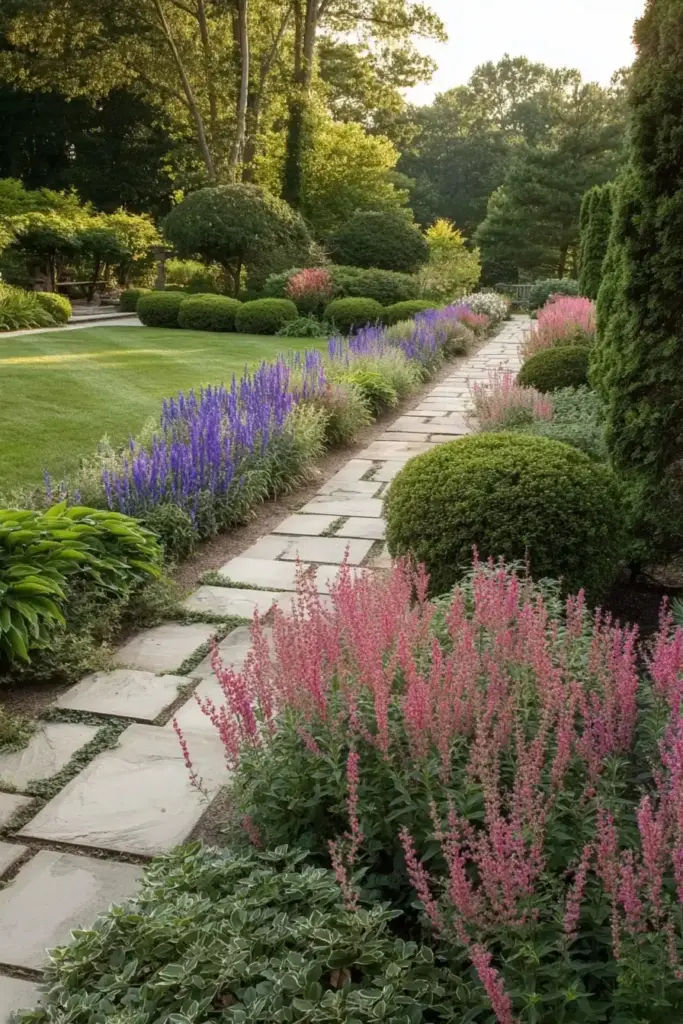
Few things enhance a garden walkway quite like vibrant, flowering edges—and that’s where salvia landscaping ideas shine again. Planting salvia along paths not only softens the lines of hardscaping but also guides the eye and foot traffic in an inviting, colorful way.
How Salvia Elevates Garden Paths:
- Creates visual rhythm that draws you naturally along the walkway
- Adds color at ground level, making paths feel lively and well-integrated
- Resistant to trampling and brushing, perfect for high-traffic zones
- Attracts bees and butterflies, turning a simple stroll into a nature experience
Choose compact varieties such as Salvia nemorosa or Salvia farinacea that won’t flop into the walkway but still offer strong blooms. Alternate colors for a variegated effect, or stick with one tone for a more formal and cohesive look.
🏡 7. Cottage Garden Charm
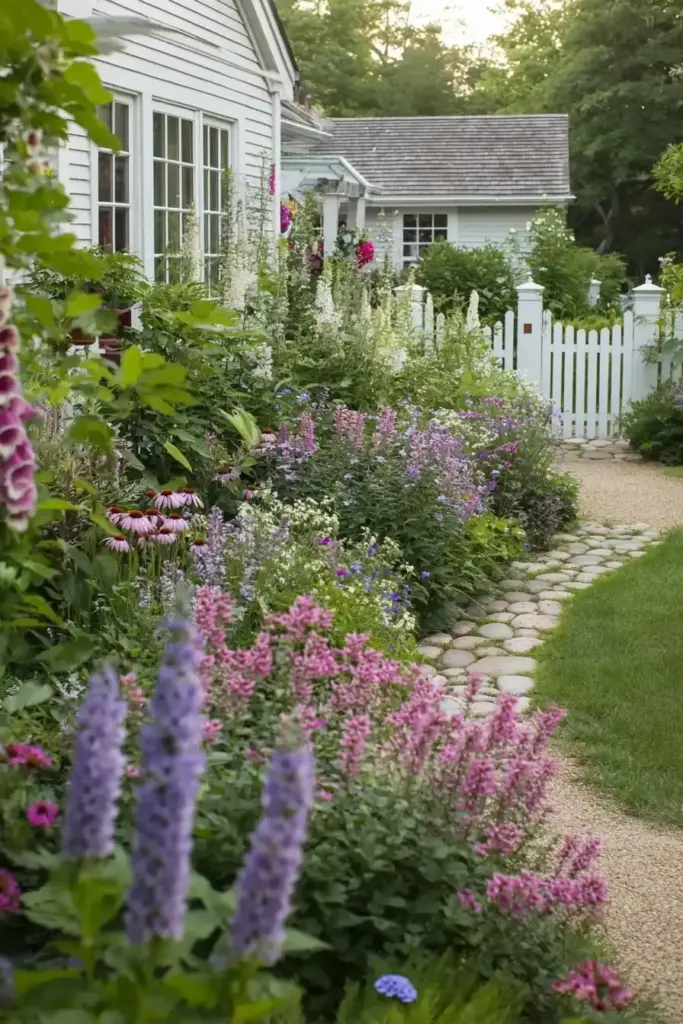
Few planting styles are as romantic and inviting as the cottage garden—and salvia landscaping ideas are a natural fit. Salvia’s upright form and rich colors add depth and rhythm to the informal sprawl of a cottage-style garden. Pairing well with roses, foxgloves, delphiniums, and daisies, salvia offers both structure and softness.
Why Salvia Belongs in a Cottage Garden:
- Bridges the gap between tall and trailing plants, offering a balanced mid-layer
- Blooms for months, supporting the continuous-flower look typical of cottage design
- Comes in a range of colors to harmonize with diverse plant palettes
- Encourages pollinators, adding life and energy to the garden
For the best results, layer salvias in drifts with other classic perennials. Let plants mingle and self-seed freely—it’s part of the charm. Choose varieties like Salvia nemorosa ‘Caradonna’ or Salvia sclarea (clary sage) for their old-world appeal and generous blooming.
🌾 8. Unexpected Pairings
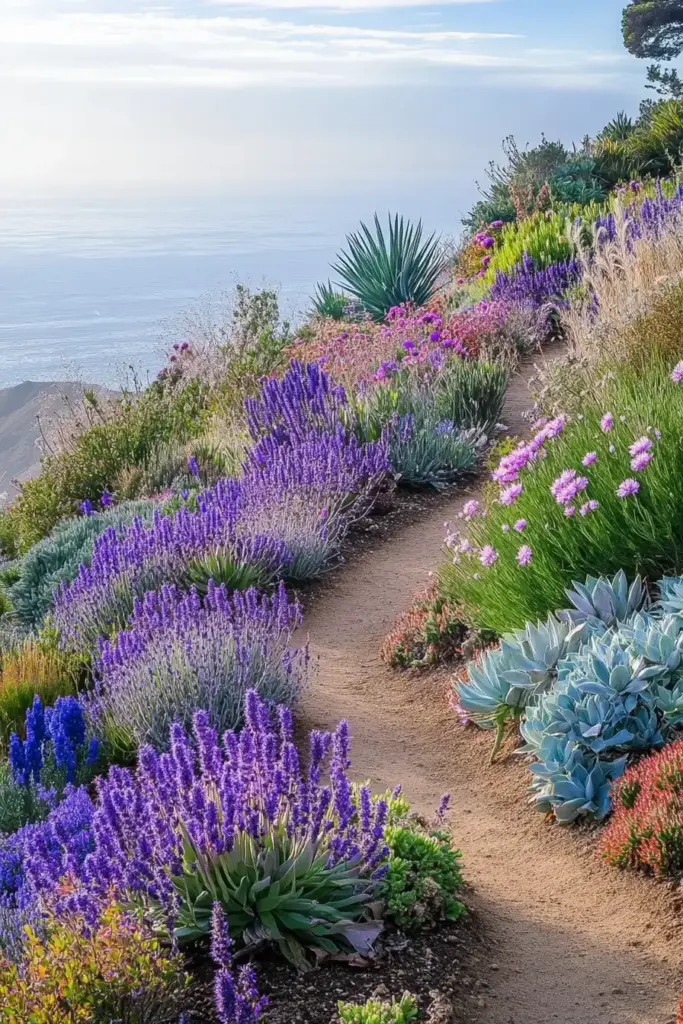
One of the most creative salvia landscaping ideas involves breaking traditional planting rules and experimenting with bold, unexpected combinations. Salvia’s vertical form and rich colors make it the perfect partner for plants with contrasting textures and shapes—like succulents, ornamental grasses, or even tropical foliage.
Unique Plant Combos That Work:
- Salvia + Succulents: The soft blooms of salvia play off the sculptural, fleshy leaves of succulents like echeveria or sedum
- Salvia + Ornamental Grasses: Try mixing with fountain grass or blue fescue for motion and a naturalistic feel
- Salvia + Tropical Plants: Salvia’s upright flowers can complement the bold leaves of canna lilies or elephant ears
These pairings add intrigue and dimension to garden beds, pots, or borders. The key is contrast: soft vs. spiky, upright vs. sprawling, matte vs. glossy. Try experimenting with small patches before scaling up—you might discover your garden’s most eye-catching combo yet.
🎨 9. Contrast and Complement
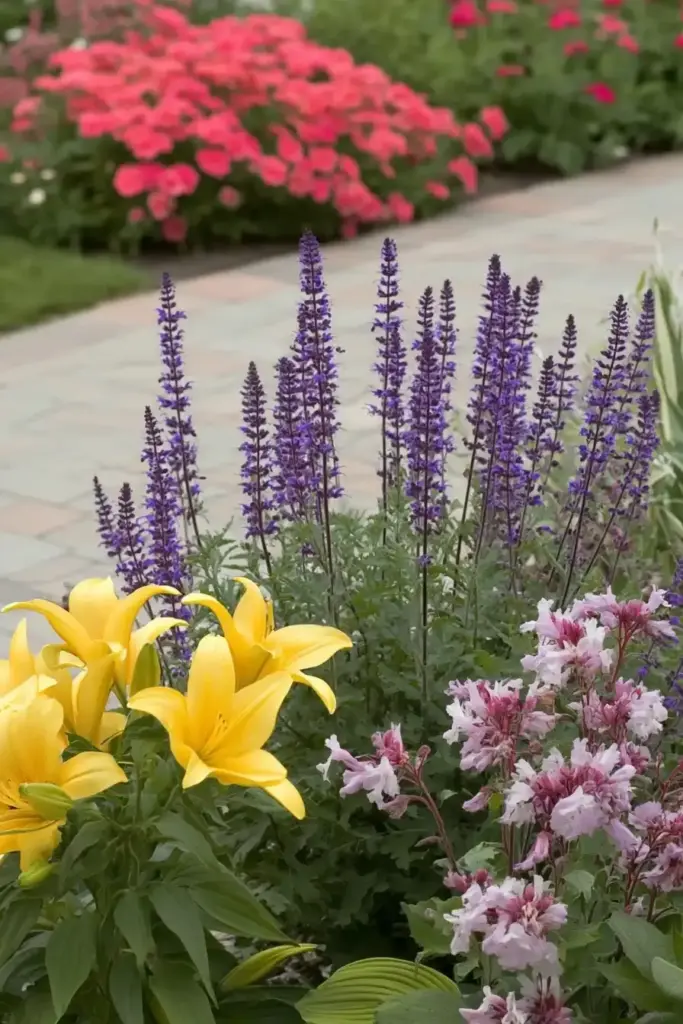
If you’re looking to highlight the beauty of your favorite flowers, salvia landscaping ideas offer a smart way to enhance other plants through contrast. With their spiky blooms and intense hues, salvias act like natural highlighters—framing softer blooms or providing a bold backdrop to lighter colors.
How Salvia Enhances Other Plants:
- Creates color contrast: Deep purples and blues make yellows, whites, and pinks pop
- Offers vertical shape: Pairs beautifully with rounded or cascading forms like peonies or creeping thyme
- Builds visual balance: Their uniform flower spikes can bring cohesion to mixed beds
- Extends the bloom window: Salvias often flower before or after companion plants, keeping beds in color longer
Try placing Salvia ‘May Night’ behind golden daylilies, or mix Salvia ‘Hot Lips’ with pale pink roses. This technique works well in both formal and informal beds, giving you a polished but natural look.
🕰 10. Seasonal Showstopper
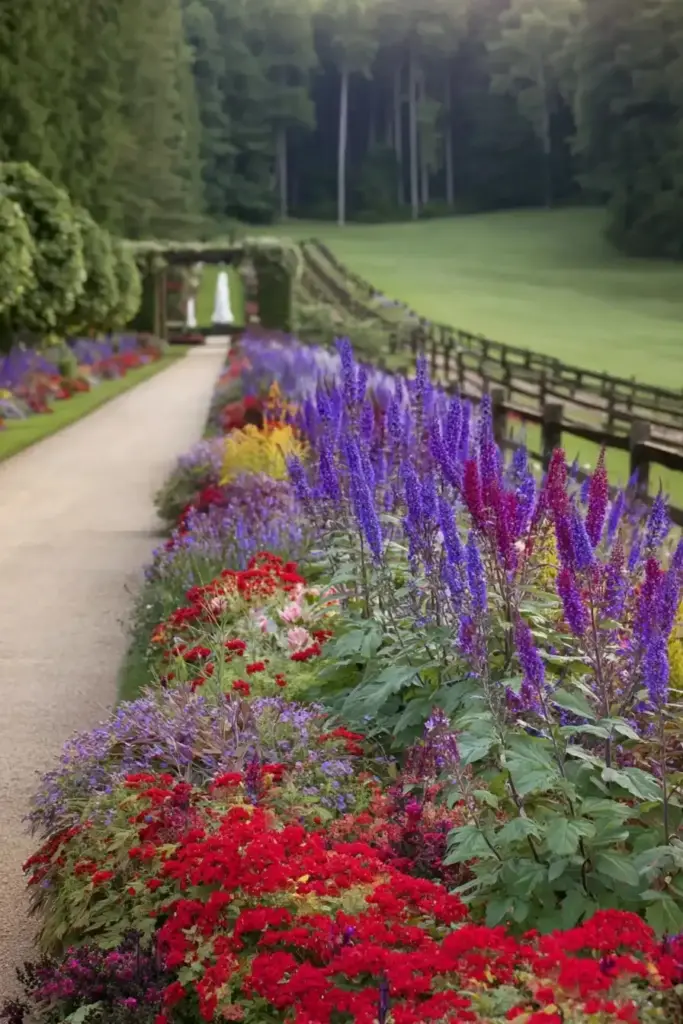
One of the most practical salvia landscaping ideas is planting a mix of salvia varieties with staggered bloom times. This simple strategy turns your garden into a near year-round display of color, ensuring there’s always something eye-catching in bloom—even as seasons shift.
Benefits of Staggered Salvia Planting:
- Extended color display, from early spring through late fall
- Supports pollinators throughout more of the growing season
- Smooth seasonal transitions in your flower beds
- Reduces bare spots, keeping your garden vibrant all year
Start with early bloomers like Salvia sylvestris in spring, follow with mid-season stars like Salvia nemorosa, and round it out with late bloomers like Salvia leucantha (Mexican bush sage) in fall. Planting this way ensures continuous visual interest and keeps the pollinator party going long after many other flowers fade.
🏗 11. Vertical Interest
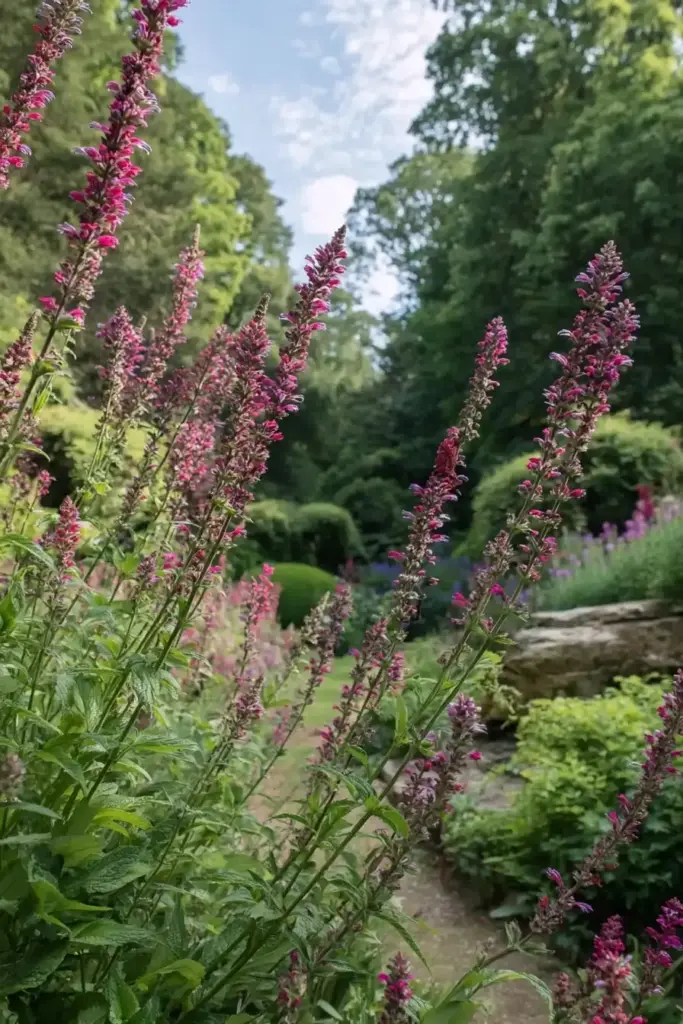
For gardeners designing in layers or limited by space, salvia landscaping ideas that emphasize vertical height are a game-changer. Tall salvia varieties like Salvia guaranitica or Salvia ‘Amistad’ can soar up to 4 feet or more, offering striking vertical accents that draw the eye upward and create depth in flower beds.
Why Use Tall Salvias?
- Adds dimension to flat or compact garden areas
- Works as a backdrop for smaller perennials or ground covers
- Breaks visual monotony in linear or symmetrical designs
- Creates privacy or gentle screening in outdoor spaces
For added impact, position tall salvia along fences, at the back of garden beds, or even in containers with trellises. Their upright spikes add architectural flair, while the rich blooms continue to attract hummingbirds and butterflies well into the season.
🧱 12. Pathway Edging
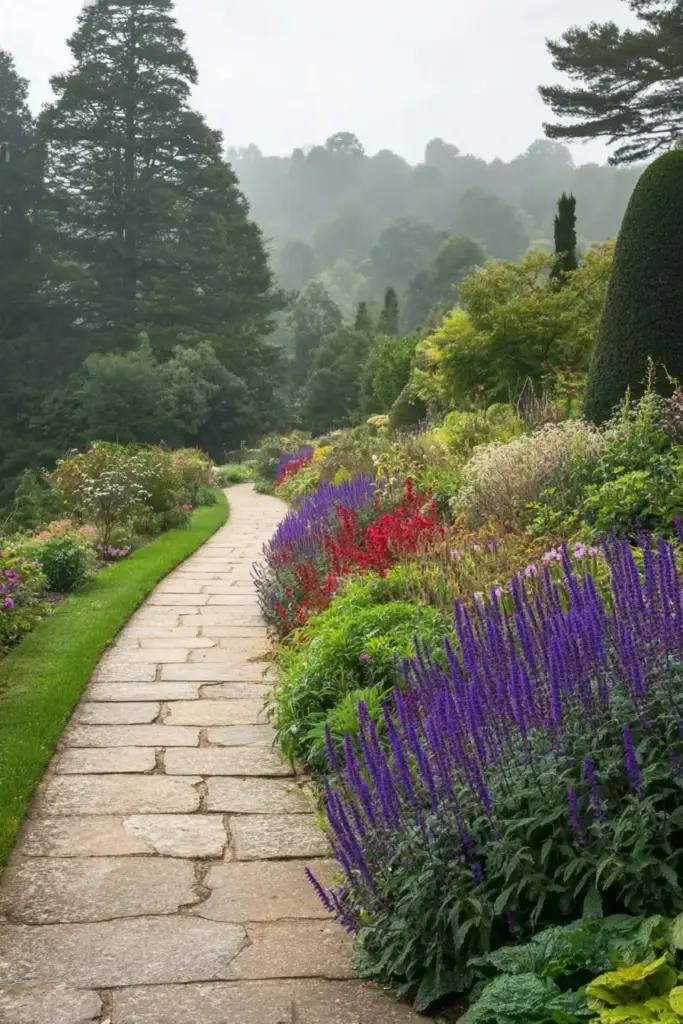
Another elegant way to use salvia landscaping ideas is by incorporating them as edging plants along pathways and walkways. Their structured growth habit and vivid blooms help define lines in the landscape while softening the edges of hard surfaces like stone or brick.
Why Salvia Is Ideal for Edging:
- Creates a natural frame for walkways, guiding movement and enhancing symmetry
- Provides long-lasting color, often blooming from late spring to fall
- Withstands heat and foot traffic proximity, making them durable in high-use areas
- Pairs well with hardscaping, offering visual contrast and softness
For a refined look, plant compact salvia types such as Salvia nemorosa ‘Blue Hill’ or Salvia greggii in evenly spaced rows along your path. Their tidy form and vibrant hues will turn even a simple walkway into a showpiece.
🌿 13. Container Gardens
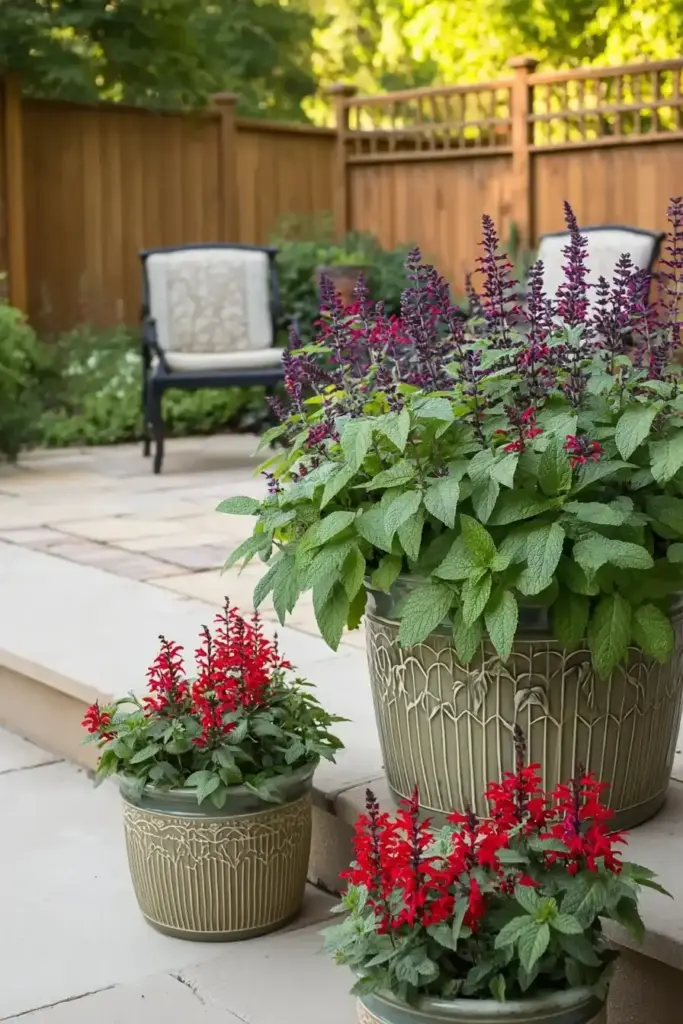
If you’re short on space or want to add flexible splashes of color to patios, balconies, or entryways, salvia landscaping ideas work beautifully in containers. Salvias adapt well to pots and planters, offering vibrant blooms and fragrant foliage with minimal upkeep.
Why Grow Salvia in Containers?
- Portable design: Easily rearrange pots to follow sun or refresh a layout
- Great for patios, porches, and small gardens
- Ideal for mixed containers with trailing plants or upright focal points
- Simplifies maintenance—better drainage and easier access for watering and pruning
Choose compact or mounding varieties like Salvia ‘Mystic Spires Blue’ or Salvia microphylla. Pair with cascading plants like sweet potato vine or calibrachoa for a lush, layered effect. Use well-draining potting mix and ensure your container has adequate drainage holes.
💐 14. Mixed Flower Beds
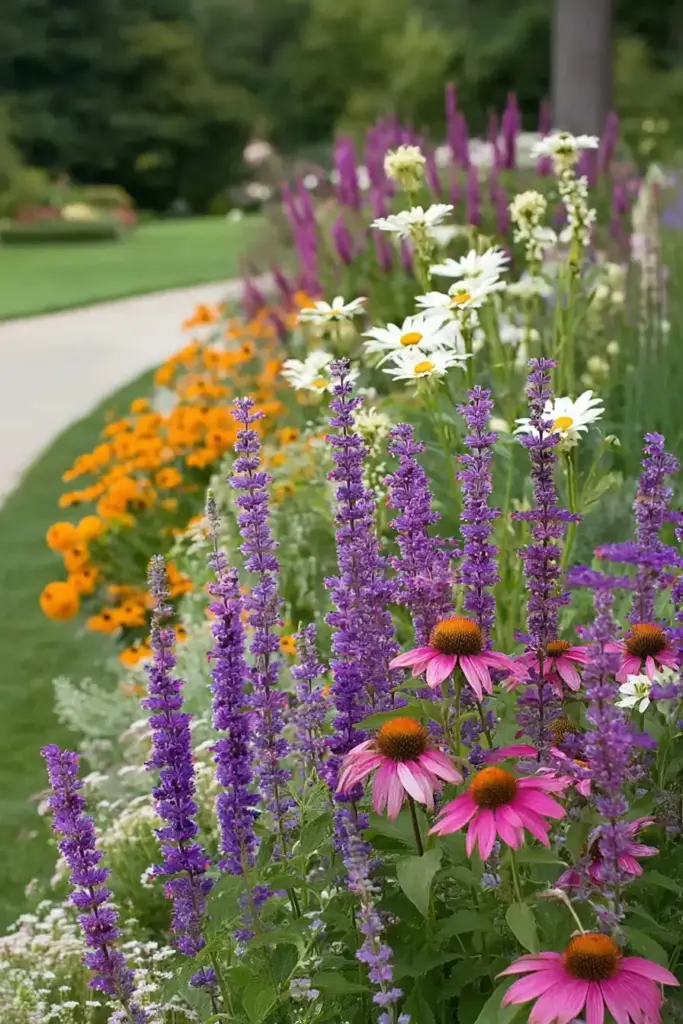
Few planting techniques are as cheerful and dynamic as mixed flower beds—and salvia landscaping ideas are at their best in these lively, layered designs. Salvias contribute rich vertical interest, color contrast, and a consistent bloom cycle, making them an ideal partner for daisies, coneflowers, rudbeckia, and more.
Why Salvias Shine in Mixed Beds:
- Create balance between bold and delicate textures
- Fill mid-height layers, bridging low growers and tall perennials
- Offer long bloom periods, ensuring constant color even when others fade
- Support pollinators, enhancing ecological diversity in your garden
For maximum effect, group salvias in odd-numbered clusters throughout the bed. Surround them with companion plants that bloom at different times or offer contrasting foliage. The result is a garden bed that feels full, layered, and alive from early spring through fall.
🌟 Conclusion
These salvia landscaping ideas highlight just how versatile and valuable salvia can be in any garden. From cottage-style flower beds and bold borders to low-maintenance rock gardens and elegant path edging, salvia offers beauty, structure, and pollinator appeal with remarkably little effort.
Whether you’re a beginner looking for easy-care perennials or an experienced gardener crafting layered designs, salvia fits right in—bringing vibrant color, seasonal interest, and fragrant foliage to your landscape. With so many varieties and uses, there’s truly a salvia solution for every space and style.
❓ Frequently Asked Questions: Salvia Landscaping Ideas
1. What are the best salvia varieties for landscaping?
Popular choices include Salvia nemorosa for borders, Salvia greggii for containers and pathways, and Salvia guaranitica for adding vertical height. Choose based on your local climate and design goals.
2. Can salvia be used in drought-tolerant landscaping?
Yes! Many salvia types are highly drought-tolerant once established, making them perfect for xeriscaping and low-maintenance garden designs.
3. How do I maintain salvia in the landscape?
Salvia requires minimal care—just full sun, well-drained soil, and occasional deadheading to encourage reblooming. Cut back in late winter or early spring to promote healthy new growth.
4. Will salvia attract pollinators to my garden?
Absolutely. Salvia is a magnet for bees, butterflies, and hummingbirds, making it a great plant for supporting local pollinators.
5. Can I plant salvia in containers?
Yes. Compact varieties like Salvia microphylla thrive in pots and can add vibrant color to patios, balconies, or small-space gardens.
6. When is the best time to plant salvia?
Spring and early fall are ideal planting times. This allows roots to establish before the stress of summer heat or winter cold.
7. How far apart should I space salvia plants?
Space salvia plants about 12 to 24 inches apart, depending on the variety. This allows good air circulation and room for growth.

